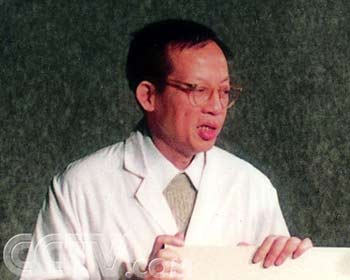∞(無窮)騎樂(yuè)
上帝不響。如歌單車......Never too late for a happy childhood (young-at-heart is so easy — pedaling a revolution from within)...
| Wang Xuan: Modern Bi Sheng | |||||||
 With the invention of a computerized laser photocomposition system for Chinese character typesetting, he proved to the world that Chinese people could independently realize the historic change from letterpress printing to electronic publishing. His invention is also described as the "second invention of the printing system for Chinese character after Bi Sheng's invention of movable clay type in the Northern Song Dynasty (960-1127), which ushered in a revolution in the history of printing. He had been often dubbed the "Modern Bi Sheng". Despite his achievements in computer sciences and his glorious titles as the academician with both the Chinese Academy of Sciences and Chinese Academy of Engineering, Wang Xuan, who died of illness Monday in Beijing at the age of 69, is more remembered by his former peers and students as a person with an enterprising and hard-working spirit and one who is easy-going and amicable. "Modern Bi Sheng" Revolutionized Chinese Character Printing "His invention marked an 'industrial revolution' in the history of printing and a great leap forward in the press industry of Born in February of In August 1974, Due to backward computer technologies and poor research conditions at that time, Wang and his colleagues faced many difficulties in developing the photo-typesetting system. "Many workers with the program felt frustrated by the many failures, but Wang often encouraged us to continue. And he often worked all nightlong for days," said Kang, with the Xinhua News Agency printery. "Wang also tried every means to guarantee that we would have a good rest after work and he often worried about our safety, especially female workers, going back home in the night," Kang recalled. Wang had been in poor health, but he was extremely diligent and devoted whole-heartedly to the photo-typesetting system for Chinese characters, Kang said. Xinhua News Agency became the first beneficiary of the laser photo typesetting by computer in 1985, and the Economic Daily became the first newspaper on the Chinese mainland to adopt the technology in 1987. Wang also helped create a Chinese-language newspaper editing and publishing system using large computer terminals, a Chinese-language laser typesetting system for color printing and a management system for news collection and editing, among others.
An "Ordinary Person" Due to his outstanding achievements, Wang won numerous awards: appraised the top ten science and technology achievements in China in 1985; was named one of middle and young experts who made eminent contributions to national science and technology in 1986; awarded Tan Kah-kee Science and Technology Prize in 1990; and awarded 1995 prize for advancement in science and technology by the Ho Leung Ho Lee Foundation. But Wang had lived a very simple life, said Xiao Jianjun, a student of Wang and a member of the board of directors of the Founder Group of the Peking University. Given his outstanding achievements and contributions to Wang usually wore casual suits and only put on Western-style clothes when he was interviewed or met with foreign guests, said Xiao. He rode a bicycle to work and never rode a car specially arranged for him by the Founder Group, when he worked at the company, Xiao said. "Wang was unassuming and amicable, and helped and cultivated young people with a noble heart," said Liu Qiuyun, deputy head of the computer Liu said, Wang Xuan often used his bonuses to award and inspire young people who made marked progress and outstanding contributions in research. In 2002, Wang used his 9 million yuan (more than US$1 million) bonus to establish the "Wang Xuan Science Research Fund" to support the research work of the computer institute of the Peking University. He invented the laser photo typesetting system for Chinese characters, but he did not name system with his own name. (Xinhua News Agency February 17, 2006)
當代畢昇王選:一直騎自行車上班 激光照排之父王選——全國政協副主席、中國科學院院士、中國工程院院士、第三世界科學院院士,北大方正控股有限公司首席科技顧問。 作為漢字激光照排係統的發明者,他推動了中國印刷技術的第二次革命,被稱為“當代畢昇”。 1975年,已經38歲的王選還是北京大學的一名普通助教。然而就是這位重病十年、隻能拿勞保的小助教,在漢字精密照排的科研項目上,卻帶領一個團隊大膽選擇了當時處於最前沿的第四代激光照排係統的研製方向。1992年,他們發明的漢字激光照排係統占領了國內99%和國外80%的中文電子排版係統市場。這一發明也把我國印刷業的發展曆程縮短了整整半個世紀,從而創造了一個漢字印刷革命的神話。 昨日,北京大學連夜為王選設立靈堂 競報 圖 告別了此生最後一個上元節,他平靜地閉上了眼睛。昨天上午11時03分,一個被稱為“當代畢昇”的69歲老人離我們遠去了。 “從某種程度上講,他的成就造就了中國紙質媒體的傳奇,每一位從中受益的媒體人都應該向他致敬,讀報的人都該記住他的名字。”在得知他的死訊後,被公認為中國報業發展核心城市的廣州,一位都市報總編這樣評價他。 全國政協副主席、中國科學院院士、中國工程院院士、第三世界科學院院士、北京大學教授王選,以他的學術成果和世人對他的尊敬為自己的人生劃上了句號。 一名熟悉王選教授的北大老師告訴記者,王選老師的身體狀況一直不是太好,中午獲知噩耗,北大師生都十分沉痛,他的辭世,是北大重大的損失。北大已經成立以許智宏校長為主任的治喪辦公室,將在北大百周年紀念講堂紀念大廳布設靈堂供師生員工吊唁,北大新聞網已專門開設了王選院士的網上悼念館。 北京大學東門對麵,屹立著王選一手帶大的“孩子”:北大方正。在方正大廈,記者依然能看到王選身後留下的恢弘事業和集團上下對他一成不變的敬重。一層大堂展覽廳中央位置,醒目地擺放著2001年江澤民為獲得最高科學技術獎的王選頒獎的照片。 醫院:死因為消化道出血 昨天下午三點多,記者趕到了王選生前所住的協和醫院。 由於王選是協和醫院的VIP病人,雖然好幾家媒體的記者都在追問,有關王選的病情,醫院並未透露多少內容。不過,記者在協和醫院住院樓地下二層的太平間裏見到了八寶山殯儀館服務站的工作人員。據這位李師傅說,王選是中午1點左右送來的,當時一起來的有幾十個人。“聽他們說好像是要在周日將遺體運走。”記者在“存放屍體手續存根”上看到:王選,69歲,死亡原因:消化道出血。 北大開設網上悼念館 本報訊 王選院士的追悼活動將從後天開始,靈堂正在緊鑼密鼓的設置中。 昨天下午三點,記者趕到北大了解到,王選院士的靈堂設在北大百年紀念講堂。下午五點開始,工作人員布置靈堂,工作人員用長16米、高6米的鐵架子做一個矩形框,工作人員介紹,矩形框以白布為底,再鋪上黑布用於貼掛照片和條幅。據了解,靈堂將於今天設置完畢,預計於明天上午9點開始開放靈堂。 據了解,王選的逝世甚至使北大原本為鏡春園、朗潤園以及全齋區域的整治工作的說明會都因此而推遲舉行。但北大還是當即就成立了以北大校長許智宏院士為主任的治喪辦公室,昨天下午,北大黨委常務副書記吳誌攀還主持召開了為時一個多小時的會議,重點討論了靈堂的布設工作和細節,細節甚至包括花圈的數量、挽聯等方方麵麵。 萬餘人網上留言悼念 昨天12時,北大得知王選教授病逝的消息後,立刻開設了網上悼念館,從下午2點40分,網上悼念館出現第一篇帖子開始,跟帖發表的留言就源源不斷,無論是北大的師生還是北大方正的員工,都在這個平台上訴說著各自對王選院士的哀悼之情。 北大新聞中心的工作人員告訴記者,從下午2點網上悼念館開通至晚上10點,已經有萬人在網上悼念館吊唁王選教授。 “這個速度是驚人的,充分體現出王選院士在人們心目中的地位”北京大學新聞發言人趙為民表示。 其他門戶網站也紛紛開設專題,來緬懷和悼念這位在IT和學術界都令人尊敬的前輩。 中學母校將舉行追悼活動 “噩耗!噩耗!太突然了!太突然了!”王選母校南洋模範中學的校長高屹聽到王選去世的消息難抑悲痛。高屹稱,目前上海南洋模範中學還沒有好好策劃對王選的追悼活動,但學校已經開始收集王選與該校的點滴材料,並把所有的影像資料編輯成短片,將在全校進行播放。另外,該校會在近日安排對王選的一係列追悼活動。 ——回憶—— 倪光南院士: 他的創新精神激勵我們 驚聞王選院士不幸逝世,噩耗傳來,悲痛萬分。我與王選院士相識已有20多年,可以說是老戰友了。記得最近的一次見麵是在2002年的中文信息學會會議上,那竟是我最後一次同他見麵了。 王選院士最突出的是他的創新精神。王選院士既是優秀的科學家,又是傑出的企業家;他既有精湛深厚的學術造詣,又有堅毅不拔的實幹精神。今天,雖然王選院士不幸早逝,但他的精神,他的業績,將永遠激勵著我們,我們一定要實現王選院士的未了心願,將王選院士的自主創新精神發揚光大。 老校友: 他一直騎著自行車上班 北大電子係教授金東瀚昨天聽到王選病逝的消息後,大吃一驚。兩位老人不僅是大學同級的校友,而且金東翰的妻子和王選妻子是師生關係,來往較密切。 在金東翰的印象裏,王選雖然名氣和財富都超過常人,但一直是個特別節儉,特別謙虛的人。他舉了三例:王選完全可以住進新建的140多平米的教授樓,但他一直都沒住,表示對現有的住房條件已經很滿足了,依然和妻子住在80多平米的老樓裏。王選是方正集團的領導,集團也很早就給他配了車,但是他一直是騎自行車上班。王選的衣著總是很普通,平時見了同事、同學和朋友沒有一點架子,總是熱情的打招呼。 本報綜合報道 |






